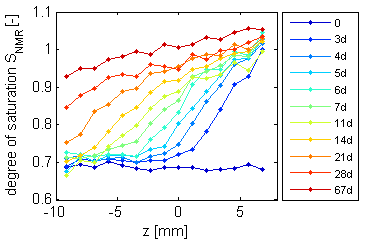One-dimensional scanning of water transport in hardened cement paste by SPI
- 1. Karlsruhe Institute of Technology (KIT), Institute for Mechanical Process Engineering and Mechanics, Karlsruhe, Germany
- 2. KIT, Institute of Concrete Structures and Building Materials, Karlsruhe, Germany
The water transport mechanism in the matrix of concrete plays an important role in different damage processes. For the formulation of a model that describes the water uptake of hardened cement paste as a function of different material and environmental parameters, it is essential to observe non-destructive and spatially resolved the water transport. For this purpose the SPI technique of 1H protons is a suitable method. It allows to observe the amount of water and thereby the degree of water saturation in the pore system with a spatial resolution of up to 0.4 mm.
To obtain a relation between the signal intensity and the moisture content of the investigated material calibration measurements on a fully water saturated sample as well as samples with defined moisture content as measured gravimetrically are required. In a first step herefore free induction decay (FID) measurements are being carried out. These allow to convert the signal intensity directly into the water content of the sample. Since this method provides the signal intensity of the entire sample only, a second approach to signal intensity measurements along the sample length was carried out. For these measurements - which will in the following be referred to as single point imaging (SPI) - a calibration method for cement paste will be presented.

All measurements were performed using a modified BRUKER minispec with B0 = 0.23 T (10 MHz). This system was extended by an actively shielded gradient system. The spatially resolved spectra were measured with the pulse sequence shown in Fig. 1, which enables to detect the fast decaying signal (T2 = 0.1-1.2 ms) of the 1H protons of the water in the concrete pore system [1][2]. The time resolution (duration of each sequence) is at least 20 min. The higher the spatial resolution should be the more time has to be invested.
The one-dimensional capillary water transport into the hardened cement paste could be investigated space-resolved up to a length of 17 mm along the propagation direction of water (Fig. 2). The echo time is 0.07 ms so that the spatial resolution is 1.14 mm. The water uptake of the pore system of the small concrete sample with a length of 2 cm and a diameter of 1 cm did not stop even after 28 days of capillary suction.

- [1] Edme H. Hardy, (2012), NMR Methods for the Investigation of Structure and Transport, Springer
- [2] S.D. Beyea, B.J. Balcom, T.W. Bremner, P.J. Prado, D.P. Green, R.L. Armstrong, and P.E. Grattan-Bellew, (1998), Magnetic Resonance Imaging and Moisture Content Profiles of Drying Concrete, Elsevier Science Ltd, Cement and Concrete Research, Vol. 28, No. 3, 453-463
